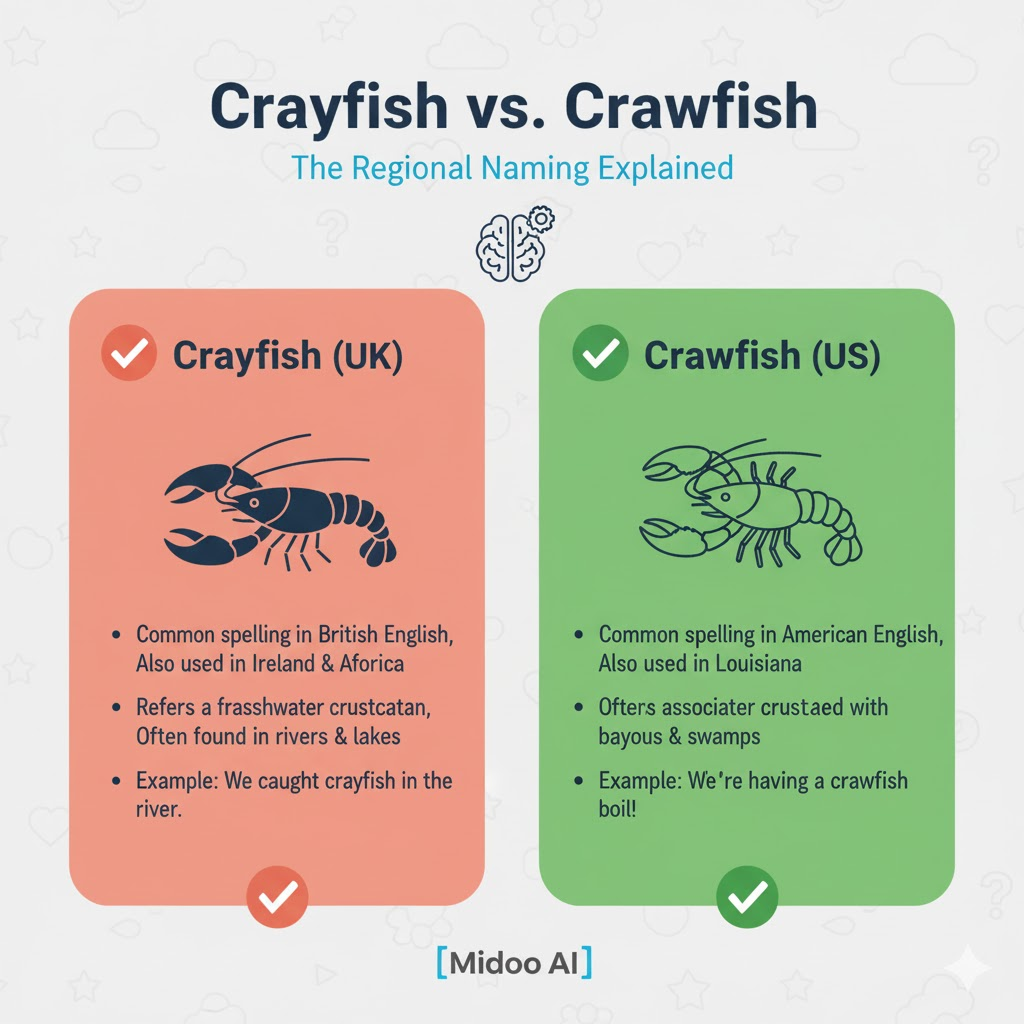Crayfish vs. Crawfish: What’s the Difference?

If you’ve ever wondered whether to say crayfish or crawfish, you’re not alone. Both refer to the same freshwater crustacean, yet English speakers around the world can’t seem to agree on which name to use.
At Midoo AI, we help learners and writers navigate these subtle but fascinating differences in English usage. Understanding when and where to use crayfish or crawfish isn’t just about spelling—it’s about culture, region, and even a bit of culinary tradition.
Let’s dive (pun intended) into how these two words came to be, how they’re used today, and how you can confidently choose the right one for your audience.
1. The Basic Difference
Both crayfish and crawfish describe the same animal: a small freshwater crustacean that looks like a tiny lobster. The difference lies mainly in regional vocabulary, not biology.
- Crayfish → Standard spelling in British English and much of the U.S.
- Crawfish → Common in Southern U.S. dialects, especially Louisiana.
There’s also a third, less common term: crawdad, which you might hear in parts of the Midwest and Western United States.
2. Crayfish in British and General English
In British English and most academic writing, crayfish is the preferred and more formal term. You’ll see it in dictionaries, biology textbooks, and environmental studies.
Examples
- “The crayfish population in the river has declined due to pollution.”
- “European crayfish species differ from those found in North America.”
- “She studied the feeding habits of the crayfish for her thesis.”
💡 Tip from Midoo AI: If you’re writing for a scientific audience, news publication, or non-American readers, crayfish is the safest and most widely accepted choice.
3. Crawfish in American English
In the Southern United States, especially Louisiana, crawfish is much more than a word—it’s a cultural symbol. Locals rarely use crayfish; instead, they celebrate crawfish boils, crawfish étouffée, and even Crawfish Festivals.
Examples
- “We had a huge crawfish boil this weekend.”
- “Louisiana’s crawfish season runs from January to June.”
- “He caught a bucket of crawfish in the bayou.”
💡 Tip: If your context involves Southern cuisine, culture, or dialect, use crawfish. It feels authentic and regionally accurate.
4. Where Each Term Is Used
| Region | Common Term | Notes |
|---|---|---|
| United Kingdom | Crayfish | Standard spelling |
| United States (general) | Crayfish | Used in education/science |
| Southern U.S. (especially Louisiana) | Crawfish | Common in culture and cuisine |
| Midwest/West (U.S.) | Crawdad | Informal, regional variant |
So while crayfish may sound more academic, crawfish carries local flavor and cultural warmth.
5. Origin and Etymology
Both words trace back to the Old French word crevice, which later evolved into crayfish in English. Over time, Southern American dialects transformed crayfish into crawfish, influenced by the regional pronunciation “craw.”
This linguistic shift is an example of folk etymology—when people change words to make them sound more natural in everyday speech.
6. Common Mistakes to Avoid
❌ “I ate crayfish étouffée in Louisiana.” (sounds odd to locals)
✅ “I ate crawfish étouffée in Louisiana.”
❌ “The scientist studied crawfish in the lab.” (too informal for scientific writing)
✅ “The scientist studied crayfish in the lab.”
💡 Tip from Midoo AI: The key is context—academic? Use crayfish. Cultural or culinary? Use crawfish.
7. Real-Life Usage Examples
- “The crayfish species in this stream are endangered.” (British English)
- “We caught crawfish in the Louisiana bayou.” (American South)
- “Kids love learning about crayfish in biology class.” (U.S. general)
- “The crawfish boil brought the whole neighborhood together.” (Louisiana)
8. Quick Memory Tricks
- 🧠 Crayfish → Classroom: Use crayfish for science or formal writing.
- 🍽️ Crawfish → Cajun: Use crawfish for Louisiana culture and food.
- 🦞 Both are the same creature—just spelled differently across regions.
✍️ Tip from Midoo AI
If you often switch between British and American contexts, consistency matters more than correctness. Midoo AI can automatically detect your writing region and suggest the appropriate variant—crayfish or crawfish—based on tone and audience.
🧩 FAQS
Q1: Are crayfish and crawfish the same animal?
Yes, they are exactly the same species—small freshwater crustaceans similar to lobsters.
Q2: Which spelling should I use in formal writing?
Use crayfish in formal, scientific, or international English contexts.
Q3: Why do people in Louisiana say “crawfish”?
It’s part of regional dialect and culture. The term crawfish is deeply rooted in Southern U.S. identity and cuisine.
Q4: Is “crawdad” a real word?
Yes! It’s an informal American regional term, mostly used in the Midwest and Western states.
Q5: Does Midoo AI correct these words automatically?
Yes. Midoo AI recognizes both crayfish and crawfish as valid and adjusts based on your language setting (U.K. or U.S.)—helping you stay consistent effortlessly.